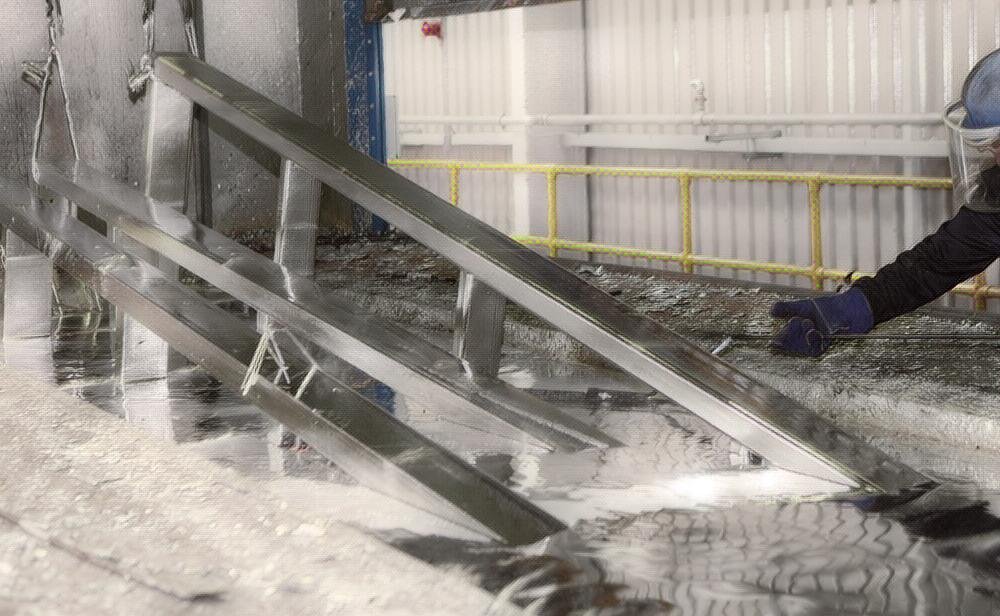Galvanizing is a critical process for protecting steel from corrosion, but costs in Australia can vary widely based on factors like zinc prices, project size, and design complexity. Here’s a detailed breakdown to help you budget effectively and explore cost-saving strategies.
📊 Key Cost Drivers
- Steel Weight: Galvanizing is priced per kilogram, with rates typically ranging from $2.50–$6.00/kg [*]. Larger, heavier items (e.g., structural beams) often cost less per kg than lightweight components like mesh or small RHS sections.
- Zinc Prices: Zinc costs fluctuate monthly. As of May 2025, prices hover around $4,513– $5,028 per tonne, directly impacting surcharges. For example, a 32.28% surcharge applies in May 2025 due to April’s zinc price of $5,028/tonne.
- Design Complexity:
- Double-dipping: Oversized items requiring two dips can double costs.
- Pre-cleaning: Removing paint, oil, or existing coatings adds $0.50– $1.50/kg.
- Coating Thickness: Thicker coatings (e.g., HDG600) use more zinc, increasing expenses.
💵 Cost Breakdown
1. Base Rate
- Standard Projects: 2.50–2.50–6.00/kg, depending on volume and item size.
- Example: A 500 kg structural beam → $1,500– $3,000.
- Light vs. Heavy Sections:
- Heavy beams (e.g., 900WB): Lower rate/kg due to efficient dipping.
- Small RHS (25×25): Higher rate/kg due to handling and space constraints.
2. Surcharges
- Zinc Levy: Tied to London Metal Exchange (LME) prices. Expect surcharges of 27–32% in mid-2025.
- Double-Dipping: Adds ~100% to base costs for oversized items.
- Pre-Cleaning: Mandatory for coated or dirty steel, adding $50– $150 to a 100 kg project.
3. Hidden Costs
- Transport: Delivery fees range from small for $100+ items to $1000+ for bulk orders.
- Design Adjustments: Adding venting holes or smoothing edges to prevent explosions during dipping.

🏗️ Example Projects
| Item | Weight | Base Cost | Surcharges | Total (AUD) |
|---|---|---|---|---|
| Farm Shed Cladding (100 m²) | 500 kg | $3.00/kg | Zinc levy (32%) | $1,980 |
| Double-Dipped Pipeline | 200 kg | $5.00/kg | Double dip (+$500) | $1,500 |
| Fence Posts (10 units) | 50 kg | $4.50/kg | Pre-clean ($1/kg) | $275 |
🌐 Zinc Price Trends & Impact
- Zinc prices surged 66%+ from 2016–2023 and remain volatile.
- Long-Term Outlook: Global demand for infrastructure and renewable energy projects keeps prices elevated. Track LME updates to anticipate surcharge changes.
🏡 Cladding Costs Comparison
For farm sheds and roofing, galvanized steel competes with alternatives like:
- Zincalume®:
- Cost: $13–$20/m²
- Pros: Lightweight, scratch-resistant, ideal for most farm sheds.
- Cons: Shiny appearance may clash with surroundings.
- Colorbond®:
- Cost: $20–$28/m²
- Pros: 20+ color options, UV-resistant, council-friendly.
- Cons: Pricier but better for coastal areas.
- Galvanized Cladding:
- Cost: $18– $25/m²
- Pros: Superior corrosion protection for dairies or coastal zones.
- Cons: Reflective surface may not meet council aesthetic rules.
💰 Cost-Saving Strategies
- Batch Orders: Combine small items to reduce dips and handling fees.
- Optimize Design: Avoid coatings pre-galvanizing, add venting holes, and simplify shapes.
- Choose Zincalume: Save 20–30% vs. galvanized cladding for non-coastal projects.
- Cold Galvanizing: Use zinc-rich paint ($15–$30/can) for repairs or small DIY jobs.
🛠️ Long-Term Value
- Durability: Galvanized steel lasts 20–50+ years vs. 2–10 years for paint.
- Stainless Steel Comparison: While stainless steel offers near-permanent corrosion resistance, it costs 4–5x more than galvanized steel.
📞 Getting a Quote
Most Australian galvanizers (e.g., Hartway, GB Galvanizing) provide free quotes based on:
- Steel weight and dimensions.
- Design complexity (e.g., double-dipping needs).
- Current zinc surcharge.
✅ Final Takeaway:
- Small Projects: Budget $50–$500 (e.g., brackets, fencing).
- Large Infrastructure: Expect $1,500–$10,000+ (e.g., bridges, pipelines).
- Pro Tip: Use the Galvanizers Association’s Life Cycle Costing Tool to compare long-term savings vs. paint systems.
Stay rust-free and cost-smart! 🔩✨